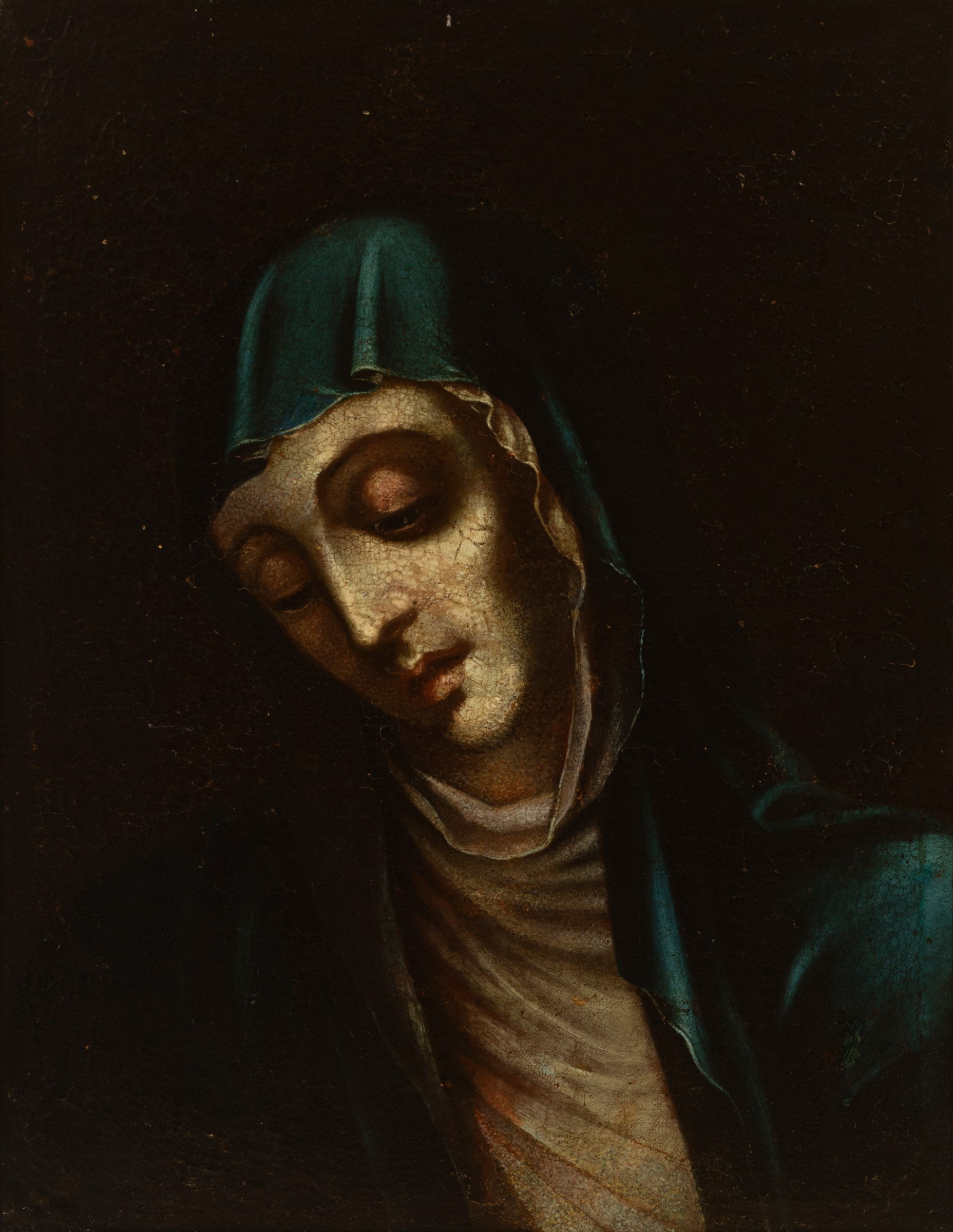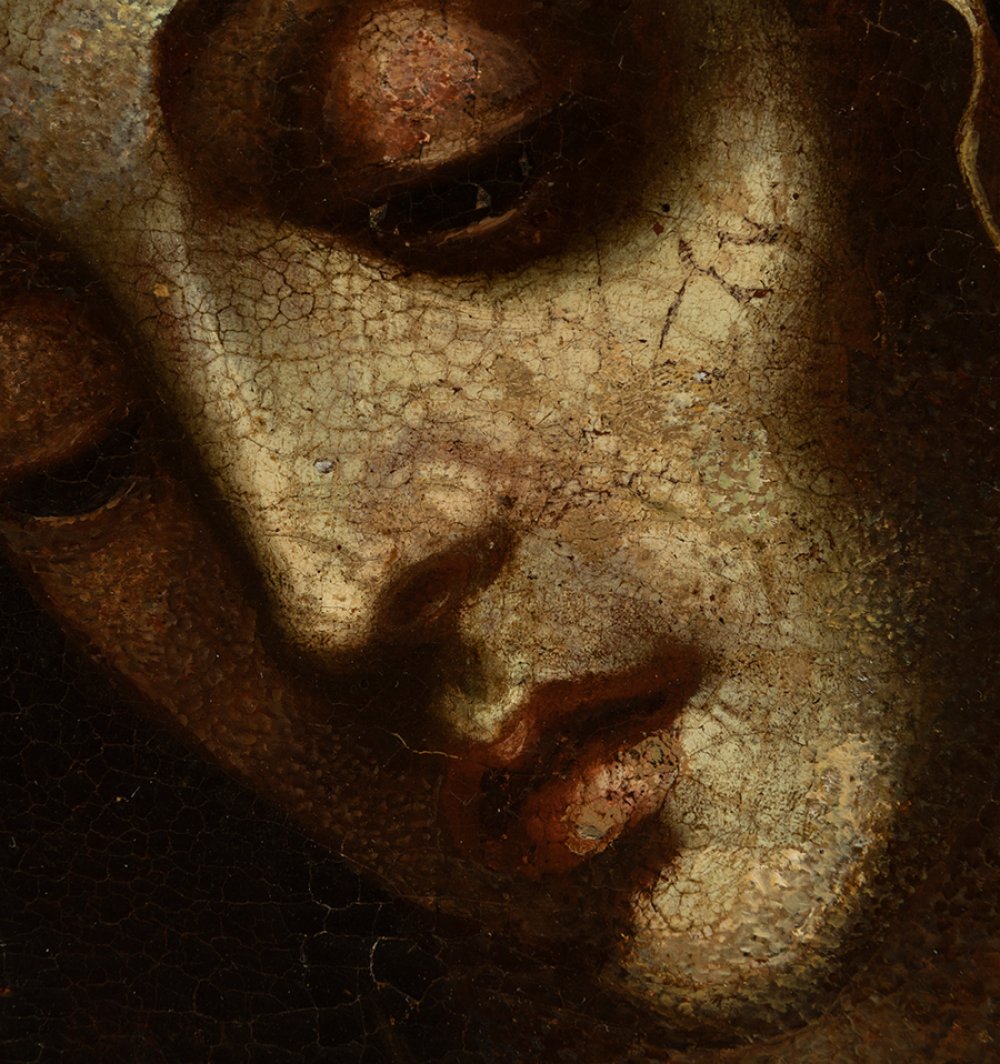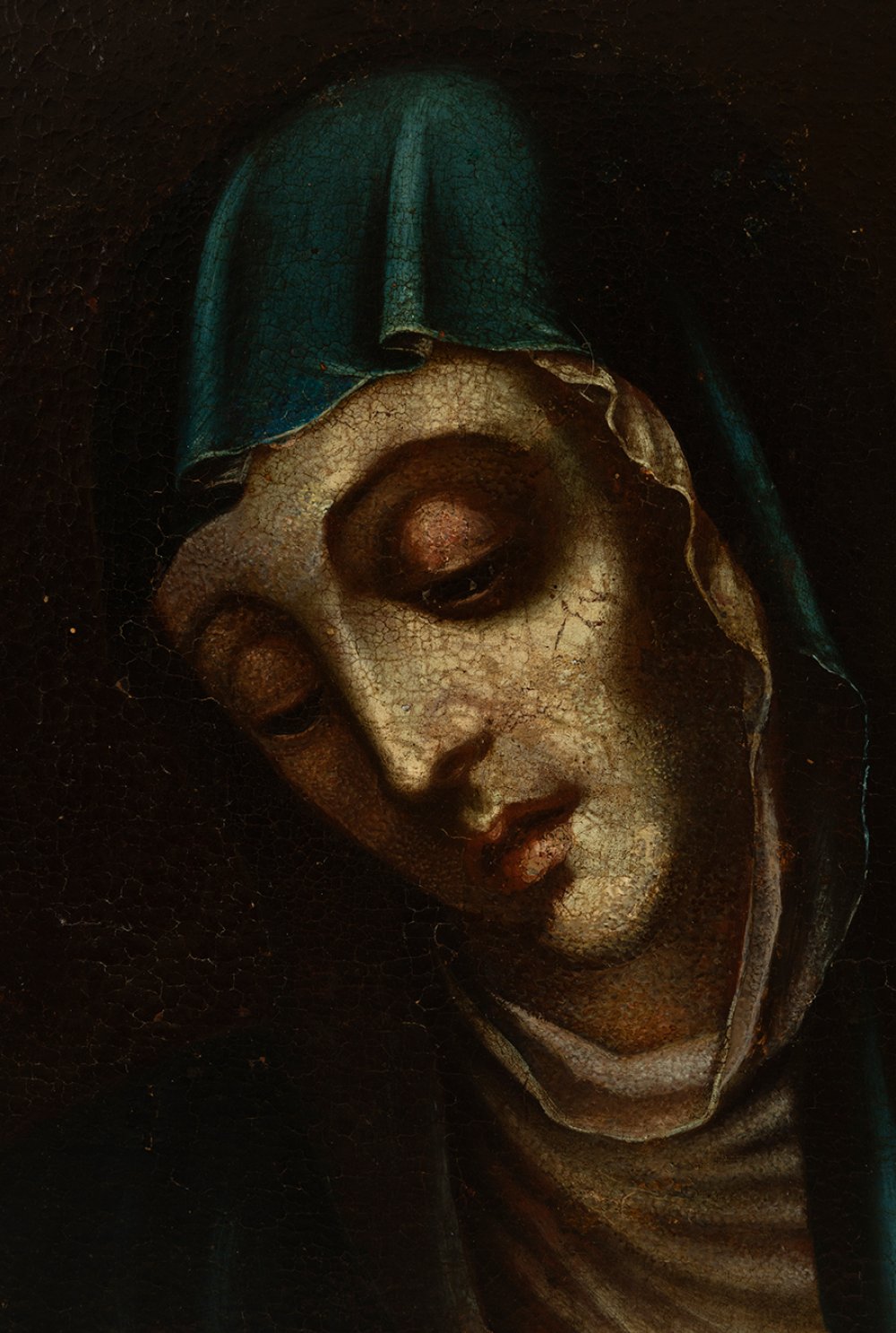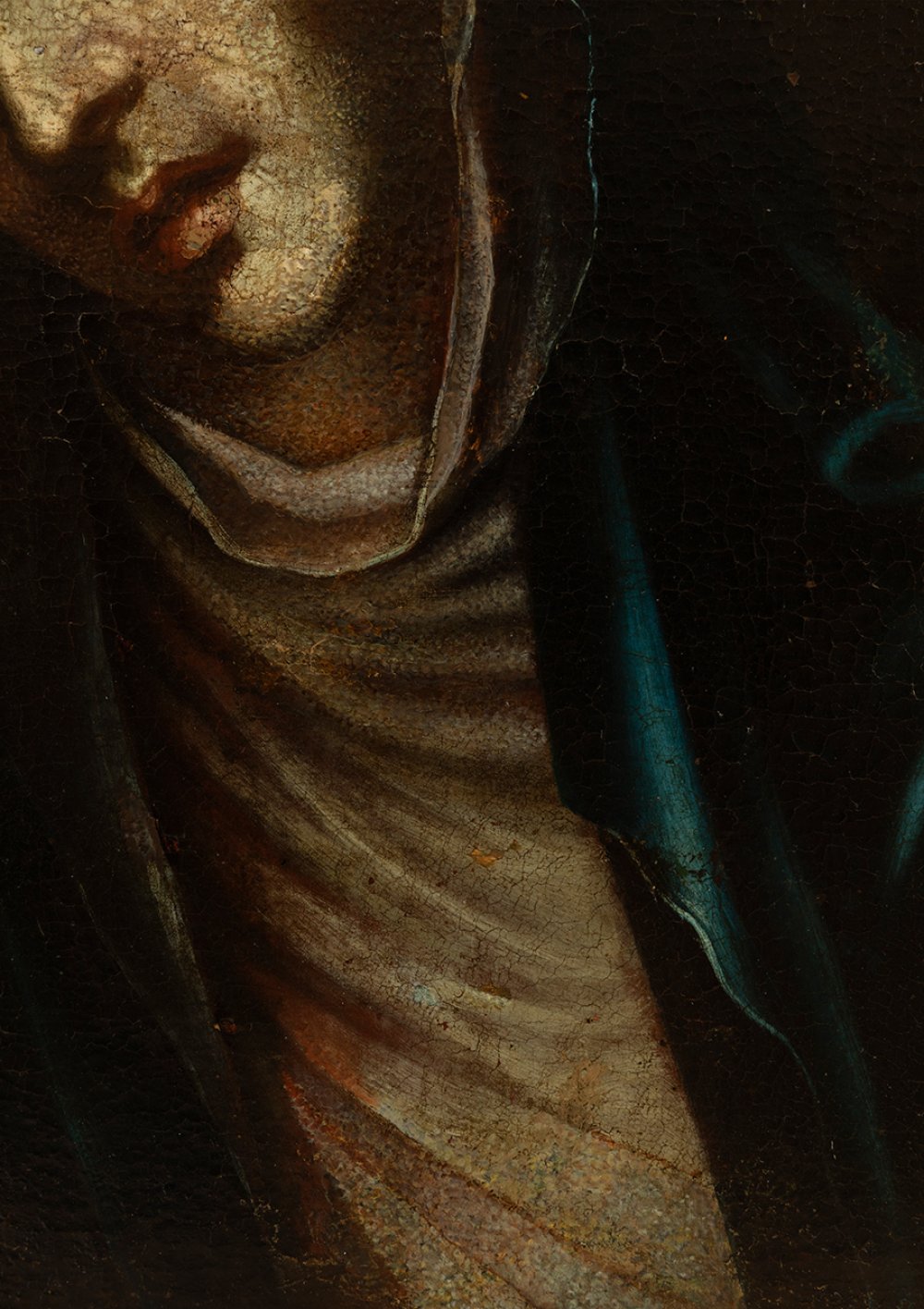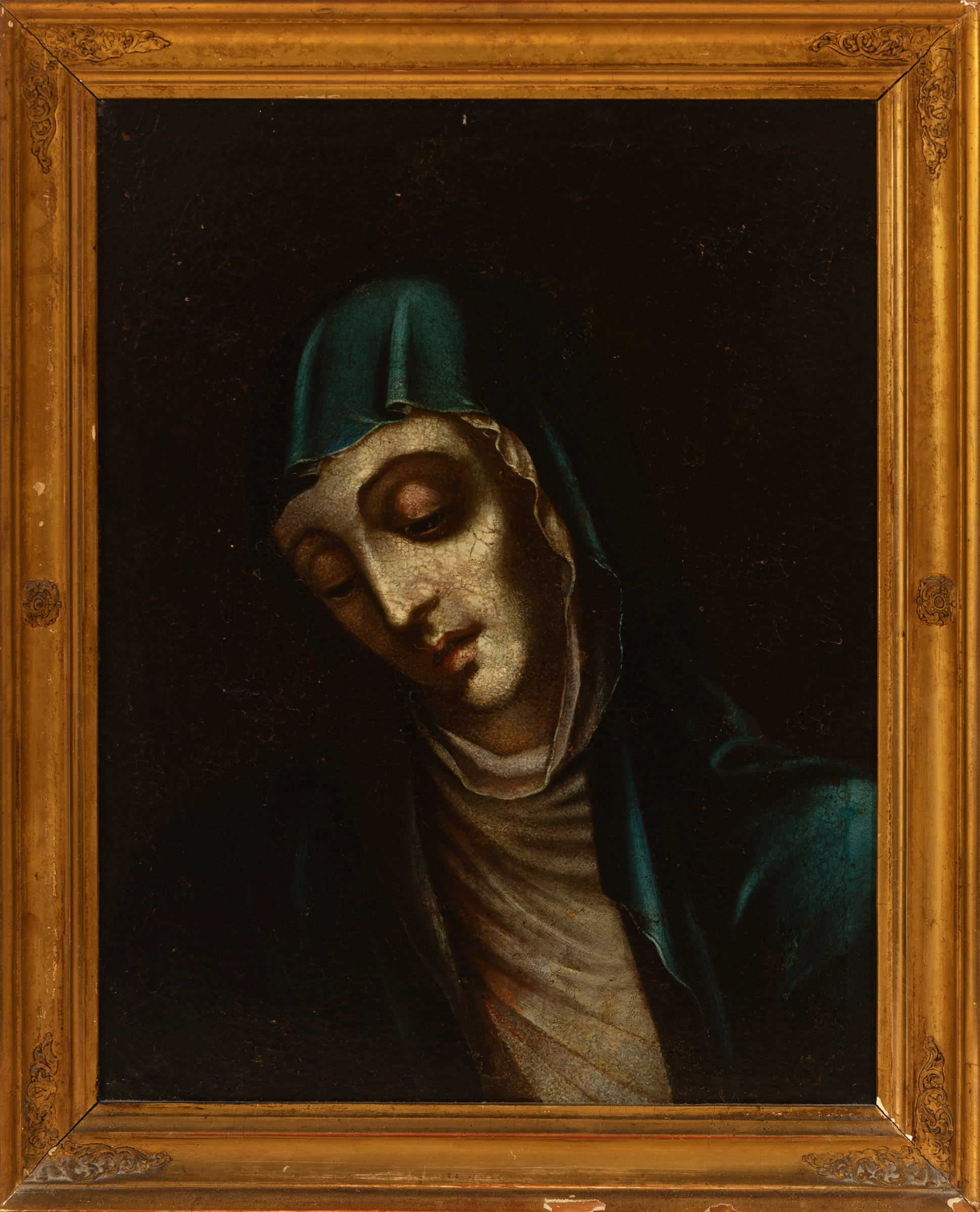4
School of LUIS DE MORALES "The Divine" (Badajoz, 1509 - Alcántara, 1586)."Virgin".Oil on canvas.
"Virgin".
Oil on canvas. Re-drawn.
It presents restorations.
It has a 19th century frame, c. 1830.
Measurements: 48 x 37 cm; 55 x 44 cm (frame).
In the Virgin's face we can also appreciate a shadow of sadness, accentuated by those clothes, which relates this work, in which the Child is absent, with the suffering of Jesus on the Cross. The tormented atmosphere in which Morales's figures breathe depicts a self-absorbed Virgin with an intense interior life, full of melancholy and ascetic renunciation, the fruit of the religious climate imposed by the Reformation movements in Spain at the time of Morales, such as mysticism and trentism. The work also denotes the Mannerist style that characterised the painter from Extremadura, with slightly elongated figures, although it presents a perfect and delicate beauty, whose face shows the influence of Raphael Sanzio, which was absorbed through the Dutch and German Mannerists.
Due to the aforementioned formal characteristics, this painting can be related to the circle of Luis de Morales, nicknamed the Divine by his first biographer, Antonio Palomino, due to the fact that he painted religious subjects with great delicacy and subtlety. Luis de Morales is considered, along with El Greco, to be one of the finest Spanish painters of the second half of the 16th century. Although there are no documentary sources or evidence of his youth, Antonio Palomino describes him as a disciple of the Flemish painter Pedro de Campaña, who lived in Seville between 1537 and 1563. This link is feasible due to the meticulousness and detailed brushstrokes characteristic of Divino, who in turn developed landscapes of Flemish heritage in his works. He travelled to Valencia to learn about the novelties contributed by the Leonardesque Fernando Yáñez and Fernando de Llanos and the Raphaelesque Vicente and Juan Masip, where he in turn became acquainted with the Lombard tradition of Bernardino Luini and Cristoforo Solario. Luis de Morales thus became one of the key painters in the history of art due to the human types depicted in his works. He extended his production to Portugal, especially to Évora and Elvas, cities near his native city of Badajoz. He settled in this city in 1539, after having worked in Plasencia, an area where there was a mixture of artists and influences from Flanders and Castile, basic characteristics for understanding Morales's painting, as well as knowledge of artists such as Alonso Berruguete and Sebastiano del Piombo. From 1570 to 1570 is his most fruitful period due to the production of numerous altarpieces, triptychs and isolated canvases, which had an enormous diffusion due to the satisfaction of the religiosity of the time, although the Extremaduran artist also demonstrates his erudite character in his canvases, as a result of his contact with enlightened clients such as the bishops of the diocese of Badajoz. Due to his enormous output and the constant demand for his iconographic themes, Morales was obliged to maintain a large workshop in which his two sons, Cristóbal and Jerónimo, collaborated. His works are now to be found in the most important collections around the world, including the Prado Museum. His presence in the latter has recently led the Spanish art gallery to devote an entire exhibition to him, curated by Leticia Ruiz, head of the Prado Museum's Department of Spanish Renaissance Painting.
"Virgin".
Oil on canvas. Re-drawn.
It presents restorations.
It has a 19th century frame, c. 1830.
Measurements: 48 x 37 cm; 55 x 44 cm (frame).
In the Virgin's face we can also appreciate a shadow of sadness, accentuated by those clothes, which relates this work, in which the Child is absent, with the suffering of Jesus on the Cross. The tormented atmosphere in which Morales's figures breathe depicts a self-absorbed Virgin with an intense interior life, full of melancholy and ascetic renunciation, the fruit of the religious climate imposed by the Reformation movements in Spain at the time of Morales, such as mysticism and trentism. The work also denotes the Mannerist style that characterised the painter from Extremadura, with slightly elongated figures, although it presents a perfect and delicate beauty, whose face shows the influence of Raphael Sanzio, which was absorbed through the Dutch and German Mannerists.
Due to the aforementioned formal characteristics, this painting can be related to the circle of Luis de Morales, nicknamed the Divine by his first biographer, Antonio Palomino, due to the fact that he painted religious subjects with great delicacy and subtlety. Luis de Morales is considered, along with El Greco, to be one of the finest Spanish painters of the second half of the 16th century. Although there are no documentary sources or evidence of his youth, Antonio Palomino describes him as a disciple of the Flemish painter Pedro de Campaña, who lived in Seville between 1537 and 1563. This link is feasible due to the meticulousness and detailed brushstrokes characteristic of Divino, who in turn developed landscapes of Flemish heritage in his works. He travelled to Valencia to learn about the novelties contributed by the Leonardesque Fernando Yáñez and Fernando de Llanos and the Raphaelesque Vicente and Juan Masip, where he in turn became acquainted with the Lombard tradition of Bernardino Luini and Cristoforo Solario. Luis de Morales thus became one of the key painters in the history of art due to the human types depicted in his works. He extended his production to Portugal, especially to Évora and Elvas, cities near his native city of Badajoz. He settled in this city in 1539, after having worked in Plasencia, an area where there was a mixture of artists and influences from Flanders and Castile, basic characteristics for understanding Morales's painting, as well as knowledge of artists such as Alonso Berruguete and Sebastiano del Piombo. From 1570 to 1570 is his most fruitful period due to the production of numerous altarpieces, triptychs and isolated canvases, which had an enormous diffusion due to the satisfaction of the religiosity of the time, although the Extremaduran artist also demonstrates his erudite character in his canvases, as a result of his contact with enlightened clients such as the bishops of the diocese of Badajoz. Due to his enormous output and the constant demand for his iconographic themes, Morales was obliged to maintain a large workshop in which his two sons, Cristóbal and Jerónimo, collaborated. His works are now to be found in the most important collections around the world, including the Prado Museum. His presence in the latter has recently led the Spanish art gallery to devote an entire exhibition to him, curated by Leticia Ruiz, head of the Prado Museum's Department of Spanish Renaissance Painting.
28th September - Old Masters
Sale Date(s)
Venue Address
General delivery information available from the auctioneer
Setdart offers Worldwide shipping
PICK UP IN ROOM: You can come and pick up your lots in our offices (Barcelona, Madrid or Valencia). At the moment of the withdrawal, you will be able to accept the current conditions of the lot by means of a document that you will sign.
YOU CAN SEND ANOTHER PERSON TO PICK UP: This person must present a signed authorization that you can find in our web page by accessing from BUY AT SETDART- LOGISTICS-DOWNLOAD AUTHORIZATION DOCUMENT. You can also send an e-mail with the requested data in AUTHORIZATION DOCUMENT to admin@setdart.com
Important Information
25% buyer´s premium
21% buyer´s premium at www.setdart.com
Terms & Conditions
The maximum period to pay the lots is 7 working days. You can pay either via bank transfer or with credit card through our platform www.setdart.com (we only accept VISA or Mastercard).
BUYER´S PREMIUM: 22% Hammer price + 21% VAT from the buyer´s premium
If your piece has more than 100 years, our Ministry of Culture requires an export certificate in order for the piece to leave the country. Note that if the piece goes inside the EU, there is no cost for the export certificate. If the piece goes outside the EU, there is a cost for the export certificate. You can find more information in our Ministry of Culture website: https://www.culturaydeporte.gob.es/en/cultura/patrimonio/exportacionimportacion/exportacion/tasas.html
INQUIRIES: admin@setdart.com
Setdart guides you through the entire process, from the time of award to the day you receive your lot. Our logistics team will be happy to manage your transport, and will advise you on the best shipping method with professionals from the sector used to handling works of art and jewelry.
WE OFFER WORLDWIDE DOOR TO DOOR SHIPPING
PICK UP IN ROOM: You can come and pick up your lots in our offices. At the moment of the withdrawal, you will be able to accept the current conditions of the lot by means of a document that you will sign.
YOU CAN SEND ANOTHER PERSON TO PICK UP: This person must present a signed authorization that you can find in our web page by accessing from BUY AT SETDART-LOGISTICS-DOWNLOAD AUTHORIZATION DOCUMENT. You can also send an e-mail with the requested data in AUTHORIZATION DOCUMENT to admin@setdart.com
SETDART IS NOT RESPONSIBLE FOR THE STATE OF THE PARTS ONCE THEY LEAVE OUR FACILITIES. MRW SHIPMENTS: Once the payment is made, your lot will be packed for shipment, the logistics department will send you an e-mail notifying you of the day it leaves our warehouse, changes of address cannot be made after receiving this e-mail.
INSURANCE INCIDENTS: Coverage for the value of the auction up to 3000 ? per shipment, if the value of the auction is higher, Setdart will send you a quote including the additional insurance. The insurance company WILL NOT BE RESPONSIBLE FOR THE SHIPMENT THAT EXCEEDS THAT AMOUNT AND IS NOT FULLY INSURED. MRW INCIDENTS: Maximum notification 48 hours after receipt, after which the insurance company WILL NOT BE RESPONSIBLE AND NO CLAIMS WILL BE ACCEPTED.
E-MAIL LOGISTICS: logistica@setdart.com
PICK UP YOUR MESSAGES: You can send your own messaging, prior notice via e-mail that your shipment is ready, please note 3 or 4 days in advance. This type of shipment is packaged so Setdart will provide you with a quote.
EXPENSES FOR STORAGE: We inform you that if the purchased lot is not picked up within a month, you will be charged 30€ per week per lot. Setdart Online S.L., owner of the web site "setdart.com", "setdart.net" and "setdart.org", acts as a company of Spanish nationality inscribed in the Volume 36955, sheet 182, page B-293056 of the Mercantile Registry, with registered office at Calle Aragó













